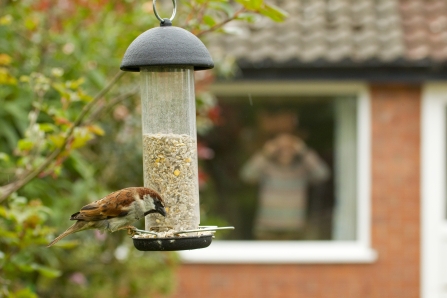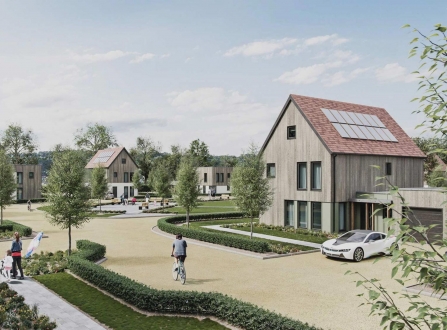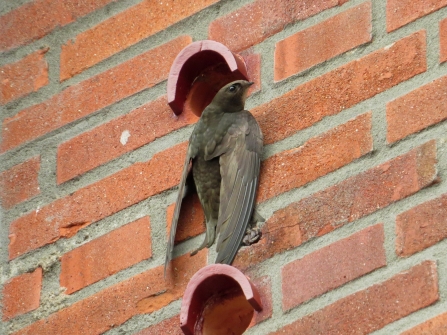One of the biggest challenges we face in the UK today is how to build homes for people without wreaking havoc on our environment and wildlife. With an ever increasing demand for housing, it is a fact of life that new houses will continue to be built. With the present climate and biodiversity crises, it is equally true that we need to change the way we live and change the homes we live in. We cannot hope to create a world in which both people and wildlife can thrive if we do not create places where both people and wildlife can live harmoniously.
Making homes for people and wildlife
Queen White-tailed bumblebee (Bombus lucorum) feeding on Yellow tree peony (Paeonia ludlowii) flower in garden by Nick Upton/2020VISION

We need to welcome the wildlife back to the places where people live. Photo by Ben Hall/2020VISION
At BBOWT, we screen about 15,000 planning applications per year, and we speak up for wildlife when we think its needs are being disregarded. But we also want to work with people and organisations who are doing the right thing for our precious environment.
We have been looking for exciting opportunities to test new technologies and techniques in housing in order to work towards sustainable living for all. That is why we are really excited to be working with Ssassy Property, our latest Investor in Wildlife, on their innovative ‘place making’ project at Springfield Meadows in Oxfordshire, which has been recognised by international sustainability charity Bioregional for demonstrating global leadership in One Planet Living.

Springfield Meadows is a new low carbon, custom build development in Oxfordshire by Ssassy Property
How to build a carbon neutral home
We are in the middle of a climate and biodiversity crisis. All new homes must tackle both of these challenges. That is the ambition of BBOWT and Ssassy in working together.
Unlike many new build homes, Ssassy homes are carbon neutral in construction and when inhabited. Ian Pritchett, a Director of Ssassy, commented: ‘A typical new home emits around 50-60 tonnes of carbon during its construction, whilst the use of bio-based materials in our homes reduces this to at or close to zero. Likewise a typical new home will emit perhaps 5 tonnes of carbon per annum, whereas Ssassy homes are designed and built to be zero carbon in use. Moving immediately to these standards for all new homes would make a huge contribution to the UK’s zero carbon ambitions.’
This is an amazing achievement, and goes to show it is possible to meet housing need without sacrificing our environment.
Bringing wildlife back
Not only are these homes carbon neutral, but they will also be havens for wildlife. BBOWT will be working with Ssassy to create habitats for wildlife throughout the development by establishing orchards, wildlife ponds, wildflower gardens, bug hotels, bird boxes and other habitats. We will also be advising on management practices for the site to ensure that it is looked after in a way that will enable wildlife to thrive year after year.
A typical new home emits around 50-60 tonnes of carbon during its construction, whilst the use of bio-based materials in our homes reduces this to at or close to zero.Director at Ssassy

Wildlife-friendly features like swift bricks can make a real difference for threatened wildlife
Our three counties face immense development pressure. To ensure that our planet and local environment can thrive, all new housing developments should share Ssassy’s ambition of being carbon neutral and creating habitats for wildlife. It is no longer good enough for the natural world to be an afterthought.
As well as being something worth protecting in its own right, a healthy natural environment is the key to our future food, water and energy security. That is why it’s so inspiring to see Ssassy putting the environment at the centre of their housing developments.

BBOWT will be working with Ssassy Property to install and maintain wildlife-friendly features like ponds, orchards and other habitats across Springfield Meadows.
This is the first time we have entered into this kind of relationship. We are really excited about the prospect of helping create Springfield Meadows and monitoring it for years to come. As a pioneering project, it will have lessons to teach us about what works best for wildlife in and around housing developments. We are looking forward to nurturing a place where people and wildlife can thrive side by side – and hopefully inspiring others to follow suit. Watch this space!
